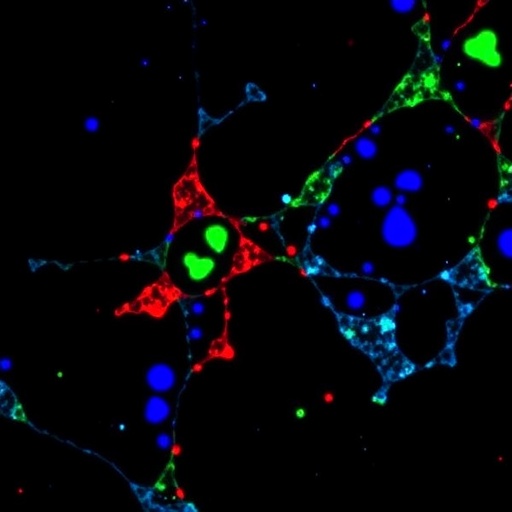
In the relentless pursuit of advancing organ transplantation and preservation, emerging research is breaking new ground by drawing inspiration from one of nature’s most extraordinary phenomena: mammalian hibernation. A pioneering study led by He, W., He, Z., Deng, W., and colleagues offers a transformative approach to organ cold preservation by modeling the intricate physiological state of hibernation, specifically focusing on the mammalian intestine. This innovative strategy holds promise to revolutionize the field of organ transplantation, potentially extending organ viability times and improving patient outcomes.
The cornerstone of this groundbreaking research lies in the biological mechanisms underlying hibernation—a natural state wherein certain mammals dramatically reduce their metabolic rates, body temperature, and physiological activity to survive prolonged periods of cold and limited food supply. By meticulously elucidating the molecular and cellular adaptations that occur during this unique physiological condition, the researchers aim to mimic these protective effects artificially, thereby enhancing the organ’s tolerance to cold preservation.
Historically, cold preservation of organs has faced significant limitations. The standard approach involves cooling organs to slow metabolic processes and reduce cellular degradation. However, cells subjected to cold temperatures still endure stress, leading to ischemia-reperfusion injury and compromised function upon transplantation. The inability to sufficiently halt deleterious biochemical and molecular processes has limited the storage duration and quality of transplantable organs, a critical bottleneck in clinical transplantation. This study’s novel approach tackles these challenges head-on by borrowing from evolutionary honed hibernation physiology.
.adsslot_cOMVSjk8PG{width:728px !important;height:90px !important;}
@media(max-width:1199px){ .adsslot_cOMVSjk8PG{width:468px !important;height:60px !important;}
}
@media(max-width:767px){ .adsslot_cOMVSjk8PG{width:320px !important;height:50px !important;}
}
ADVERTISEMENT
Central to the investigation is the complex regulation of metabolism during hibernation. Hibernators exhibit a drastic downregulation of metabolic activity, reducing oxygen consumption and substrate utilization to levels far below those seen in normal states. Through detailed transcriptomic and proteomic analyses, the team uncovered a web of signaling pathways and gene networks orchestrating this metabolic suppression. Key regulators involve AMP-activated protein kinase (AMPK) pathways, mitochondrial adaptations, and modulation of ion channel activity, collectively contributing to energy conservation and cellular protection.
The study’s focus on the intestine—a particularly vulnerable organ in transplantation—adds another layer of clinical relevance. The intestinal tissue is highly metabolic and prone to ischemic injury due to its extensive vascularization and frequent exposure to microbial populations, which can exacerbate inflammation during reperfusion. By modeling the intestinal environment under hibernation-like conditions, the researchers demonstrated a remarkable preservation of tissue integrity and barrier function during extended cold storage. These findings suggest that hibernation-inspired metabolic suppression confers resilience against cold-induced damage.
One of the study’s technical highlights lies in the development and application of sophisticated in vitro and ex vivo models that simulate the hibernation milieu. By tightly regulating temperature, oxygen levels, and nutrient supply, the researchers recreated a hibernation-like state that triggered endogenous protective mechanisms within intestinal cells. Such experimental setups allowed for precise dissection of molecular pathways and real-time assessment of functional outcomes, including epithelial barrier permeability, cell viability, and inflammatory responses.
Crucially, modulation of hypoxia-inducible factors (HIFs) emerged as a pivotal aspect of the preservation strategy. These transcription factors govern cellular responses to low oxygen conditions and are integral to hibernation physiology. Activation of HIF pathways during cold preservation was found to stabilize cellular metabolism and suppress pro-inflammatory cascades, mitigating damage that commonly afflicts preserved tissues. The capacity to pharmacologically induce HIF signaling in organ preservation solutions is particularly exciting, as it opens avenues for translational application.
The study also delves into the realm of mitochondrial dynamics, a critical determinant of cell fate under stress. During hibernation, mitochondrial function is finely tuned to balance the reduction of reactive oxygen species production with efficient energy use. The team observed that mimicking these mitochondrial states in preserved intestines prevented the activation of apoptotic pathways and maintained ATP synthesis at sustainable levels. This bioenergetic optimization is key to maintaining cellular homeostasis during the prolonged cold ischemic period.
In parallel, the investigation identified alterations in ion transport and membrane channel activity as essential components of hibernation-inspired preservation. Limiting ionic fluxes prevents cellular swelling and calcium-mediated toxicity, hallmark features of cold-induced injury. By manipulating ion channels pharmacologically, the researchers achieved enhanced stabilization of cellular membranes, further safeguarding tissue architecture during storage.
Another remarkable facet of this research is the integration of metabolomics profiling to capture the biochemical milieu of hibernation states. The accumulation of certain metabolites, such as succinate and specific amino acids, was linked to protective signaling pathways that enhance antioxidant defenses and suppress inflammatory processes. Augmenting preservation media with these metabolites replicated beneficial aspects of hibernation metabolism, highlighting a practical method to improve organ preservation solutions.
The implications of this study extend beyond the intestine to other transplantable organs vulnerable to ischemia-reperfusion injury, including the heart, kidneys, and liver. The researchers propose that the fundamental principles uncovered are broadly applicable and advocate for future studies to validate hibernation-based preservation strategies across diverse organ systems. Such cross-organ applicability would decisively address one of the most pressing challenges in transplantation medicine.
On the translational front, this research has the potential to shift paradigms in organ banking and transplantation logistics. By extending cold storage times without compromising organ viability, transplant centers could increase their reach, match donors and recipients more efficiently, and reduce the urgency and costs associated with rapid transplant surgeries. The ability to incorporate hibernation-mimicking protocols in existing preservation technologies makes this approach both innovative and feasible.
Furthermore, the study opens intriguing possibilities for personalized medicine in transplantation. Understanding inter-individual variability in response to cold preservation and hibernation-like treatments could lead to tailored preservation regimens optimized for specific donor and recipient characteristics. This level of precision may ultimately improve graft survival rates and long-term patient health.
From a biochemical standpoint, the elucidation of immune modulation during hibernation sheds light on potential therapies to mitigate post-transplant immune rejection. The natural immunosuppressive state during hibernation involves downregulation of pro-inflammatory cytokines and immune cell infiltration, phenomena that could be strategically harnessed to improve immunotolerance following organ transplantation.
This research not only advances biomedical science but also exemplifies the power of biomimicry—leveraging evolutionary adaptations to address modern medical challenges. The team’s interdisciplinary approach, combining molecular biology, physiology, bioengineering, and clinical insights, underscores the importance of integrative science in fostering innovation.
As organ transplantation demand continues to rise globally, breakthroughs such as these offer a beacon of hope. By transforming the way organs are preserved, hibernation-based methodologies could usher in a new era where the scarcity of viable donor organs no longer limits life-saving transplants.
The study by He and colleagues represents a pioneering step towards harnessing the wisdom of nature to optimize human health interventions. Ongoing research efforts aimed at refining hibernation models and testing clinical protocols will be vital to fully realize the transformative potential of this approach. Ultimately, this line of investigation holds promise not only for transplantation medicine but also for critical care scenarios where organ preservation and protection are paramount.
In conclusion, modeling mammalian hibernation to enhance organ cold preservation is a promising frontier with profound implications. By decoding and replicating the molecular choreography that governs hibernation, researchers have unveiled a novel paradigm with the capacity to extend organ viability, improve transplant outcomes, and save countless lives. The intestine serves as a compelling example, but this paradigm shift is poised to revolutionize organ preservation across medicine.
Subject of Research: Modeling mammalian hibernation to enhance organ cold preservation with a focus on the intestine.
Article Title: Modeling mammalian hibernation to improve organ cold preservation: Using the intestine as an example.
Article References:
He, W., He, Z., Deng, W. et al. Modeling mammalian hibernation to improve organ cold preservation: Using the intestine as an example. Cell Res (2025). https://doi.org/10.1038/s41422-025-01149-w
Image Credits: AI Generated
Tags: cold preservation methodsenhancing organ tolerance to coldextending organ viability timesimproving patient outcomes in transplantationischemia-reperfusion injury preventionmammalian hibernation researchmetabolic rate reduction in hibernationmolecular mechanisms of hibernationorgan preservation techniquesorgan transplantation innovationsphysiological adaptations in hibernating mammalsrevolutionary approaches in organ preservation





